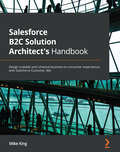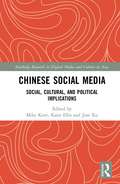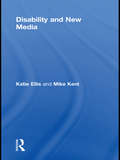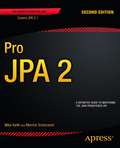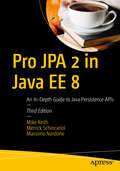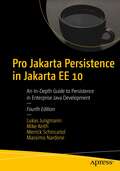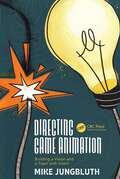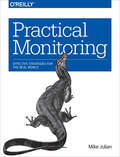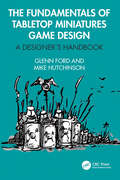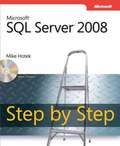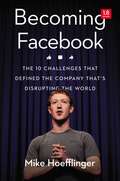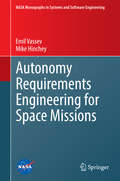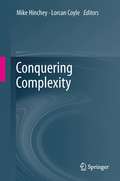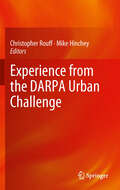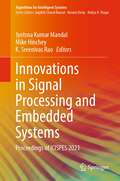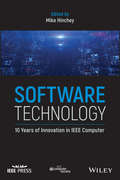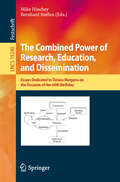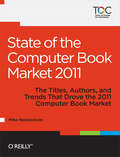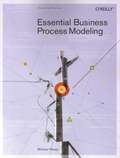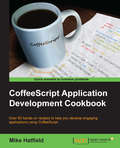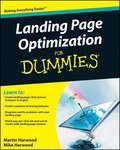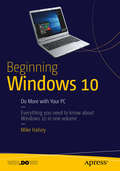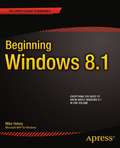- Table View
- List View
Salesforce B2C Solution Architect's Handbook: Design scalable and cohesive business-to-consumer experiences with Salesforce Customer 360
by Mike KingMaster the skills you need as a Salesforce B2C Solution Architect to design an optimized business-to-consumer (B2C) solution across the Salesforce Customer 360 ecosystem, including B2C Commerce, Service Cloud, and Marketing CloudKey FeaturesCreate a unified view of the customer across Salesforce products and beyondAvoid inefficiencies and costly rework caused by poor architectural designsPrepare for the B2C Solution Architect exam and Salesforce certification with practical scenarios following Salesforce best practicesBook DescriptionA carefully designed Customer 360 solution spanning B2C Commerce, Marketing Cloud, and Service Cloud provides the foundation for a single view of the customer, unique insights, and transformational capabilities. There is currently a huge demand in the marketplace for professionals who understand how to leverage these components together. Salesforce B2C Solution Architect's Handbook will help you understand the integration options and products that help you deliver value for organizations.You'll start by developing a solid understanding of the capabilities of each component in the Customer 360 ecosystem, their data models, and governance. As you progress, you'll explore the role of a B2C solution architect in planning critical requirements and implementation sequences to avoid costly rework. The book will also guide you through the options for integrating products with the Salesforce ecosystem and demonstrate best practices for data modeling across Salesforce products and beyond. Once you have the core knowledge required to be a successful solution architect, you'll learn about tools, techniques, and certification scenarios in preparation for the B2C Solution Architect exam.By the end of this book, you'll have the skills to design scalable, secure, and future-proof solutions supporting your customers' critical business demands.What you will learnExplore key Customer 360 products and their integration optionsChoose the optimum integration architecture to unify data and experiencesArchitect a single view of the customer to support service, marketing, and commercePlan for critical requirements, design decisions, and implementation sequences to avoid sub-optimal solutionsIntegrate Customer 360 solutions into a single-source-of-truth solution such as a master data modelSupport business needs that require functionality from more than one component by orchestrating data and user flowsWho this book is forThis book is for B2C commerce architects, application architects, integration architects, and system architects familiar with one or more products within the Customer 360 suite who want to master B2C solutions. Enterprise architects, Salesforce architects, and CTO teams at Salesforce customer organizations looking to benefit from a unified solution will also find this book helpful. A general understanding of data integration, APIs, and connected systems, along with knowledge of the fundamentals of business-to-consumer (B2C) customer experiences is necessary to get the most out of this book.
Salesforce B2C Solution Architect's Handbook: Design scalable and cohesive business-to-consumer experiences with Salesforce Customer 360
by Mike KingThe ultimate handbook for new and seasoned Salesforce B2C Solution Architects who want to design seamless B2C solutions across the Salesforce Customer 360 ecosystem – including B2C Commerce, Service Cloud, and Marketing CloudKey FeaturesGive your customers a frictionless experience by creating a unified view of all their interactionsGet your architectural design right the first time and avoid costly reworksPrepare for the B2C Solution Architect exam and Salesforce certification with practical scenarios following Salesforce best practicesBook DescriptionThere’s a huge demand on the market for Salesforce professionals who can create a single view of the customer across the Salesforce Customer 360 platform and leverage data into actionable insights. With Salesforce B2C Solution Architect's Handbook, you’ll gain a deeper understanding of the integration options and products that help you deliver value for organizations. While this book will help you prepare for the B2C Solution Architect exam, its true value lies in setting you up for success afterwards. The first few chapters will help you develop a solid understanding of the capabilities of each component in the Customer 360 ecosystem, their data models, and governance. As you progress, you'll explore the role of a B2C solution architect in planning critical requirements and implementation sequences to avoid costly reworks and unnecessary delays. You’ll learn about the available options for integrating products with the Salesforce ecosystem and demonstrate best practices for data modeling across Salesforce products and beyond. Once you’ve mastered the core knowledge, you'll also learn about tools, techniques, and certification scenarios in preparation for the B2C Solution Architect exam. By the end of this book, you’ll have the skills to design scalable, secure, and future-proof solutions supporting critical business demands.What you will learnExplore key Customer 360 products and their integration optionsChoose the optimum integration architecture to unify data and experiencesArchitect a single view of the customer to support service, marketing, and commercePlan for critical requirements, design decisions, and implementation sequences to avoid sub-optimal solutionsIntegrate Customer 360 solutions into a single-source-of-truth solution such as a master data modelSupport business needs that require functionality from more than one component by orchestrating data and user flowsWho this book is forThis book is for professionals in high-level job roles that heavily rely on Salesforce proficiency. It’s primarily written for B2C commerce architects, application architects, integration architects, as well as system architects, enterprise architects, Salesforce architects, and CTO teams looking to benefit from a deeper understanding of this platform. Before you get started, you’ll need a solid understanding of data integration, APIs, and connected systems, along with knowledge of the fundamentals of business-to-consumer (B2C) customer experiences.
Chinese Social Media: Social, Cultural, and Political Implications (Routledge Research in Digital Media and Culture in Asia)
by Katie Ellis Mike Kent Jian XuThis book brings together scholars from a variety of disciplines to address critical perspectives on Chinese language social media, internationalizing the state of social media studies beyond the Anglophone paradigm. The collection focuses on the intersections between Chinese language social media and disability, celebrity, sexuality, interpersonal communication, charity, diaspora, public health, political activism and non-governmental organisations (NGOs). The book is not only rich in its theoretical perspectives but also in its methodologies. Contributors use both qualitative and quantitative methods to study Chinese social media and its social–cultural–political implications, such as case studies, in-depth interviews, participatory observations, discourse analysis, content analysis and data mining.
Disability and New Media (Routledge Studies in New Media and Cyberculture)
by Katie Ellis Mike KentDisability and New Media examines how digital design is triggering disability when it could be a solution. Video and animation now play a prominent role in the World Wide Web and new types of protocols have been developed to accommodate this increasing complexity. However, as this has happened, the potential for individual users to control how the content is displayed has been diminished. Accessibility choices are often portrayed as merely technical decisions but they are highly political and betray a disturbing trend of ableist assumption that serve to exclude people with disability. It has been argued that the Internet will not be fully accessible until disability is considered a cultural identity in the same way that class, gender and sexuality are. Kent and Ellis build on this notion using more recent Web 2.0 phenomena, social networking sites, virtual worlds and file sharing. Many of the studies on disability and the web have focused on the early web, prior to the development of social networking applications such as Facebook, YouTube and Second Life. This book discusses an array of such applications that have grown within and alongside Web 2.0, and analyzes how they both prevent and embrace the inclusion of people with disability.
Pro JPA 2
by Mike Keith Merrick SchincariolPro JPA 2, Second Edition introduces, explains, and demonstrates how to use the new Java Persistence API (JPA) 2. 1 from the perspective of one of the specification creators. A one-of-a-kind resource, it provides both theoretical and extremely practical coverage of JPA usage for both beginning and advanced developers. Authors Mike Keith and Merrick Schincariol take a hands-on approach, based on their wealth of experience and expertise, by giving examples to illustrate each concept of the API and showing how it is used in practice. The examples use a common model from an overriding sample application, giving readers a context from which to start and helping them to understand the examples within an already familiar domain. After completing the book, you will have a full understanding of JPA and be able to successfully code applications using its annotations and APIs. The book also serves as an excellent reference guide during initial and later JPA application experiences. Hands-on examples for all aspects of the JPA specification Expert insight about various aspects of the API and when they are useful Portability hints to provide increased awareness of the potential for non-portable JPA code What you'll learn How to get started with enterprise applications using JPA 2. 1 Simple and advanced object-relational mapping techiques How to use the complete Entity Manager API How to create queries using the query language (JP QL) and the Criteria API Locking, concurrency, and other advanced concepts How to use XML mapping files and descriptors How to package and deploy your Java Persistence applications How to test your Java Persistence applications Who this book is for The book generally targets enterprise and persistence developers who fall in one of three categories: Those who are new to persistence; we will offer an introduction to persistence and to the basic concepts so these readers can have solid base from which to become proficient at JPA. Those who know and/or use existing ORM persistence products such as Hibernate or TopLink/EclipseLink. Those who have already used JPA and want to learn about newer features introduced by JPA 2. 1, or have a good reference book to consult when they develop JPA applications. In general, we assume that the reader is knowledgeable with Java, SQL, and JDBC, and has a little knowledge of Java EE. Table of Contents Introduction Getting Started Enterprise Applications Object Relational Mapping Collection Mapping Entity Manager Using Queries Java Persistence Query Language Criteria Advanced Object Relational Mapping Advanced Queries Advanced Topics XML Mapping Files Packaging and Deployment Testing
Pro JPA 2 in Java EE 8: An In-depth Guide To Java Persistence Apis
by Mike Keith Merrick Schincariol Massimo NardoneLearn to use the Java Persistence API (JPA) and other related APIs as found in the Java EE 8 platform from the perspective of one of the specification creators. A one-of-a-kind resource, this in-depth book provides both theoretical and practical coverage of JPA usage for experienced Java developers. Authors Mike Keith, Merrick Schincariol and Massimo Nardone take a hands-on approach, based on their wealth of experience and expertise, by giving examples to illustrate each concept of the API and showing how it is used in practice. The examples use a common model from an overarching sample application, giving you a context from which to start and helping you to understand the examples within an already familiar domain. After completing Pro JPA 2 in Java EE 8, you will have a full understanding of JPA and be able to successfully code applications using its annotations and APIs. The book also serves as an excellent reference guide. What You Will Learn Use the JPA in the context of enterprise applications Work with object relational mappings (ORMs), collection mappings and more Build complex enterprise Java applications that persist data long after the process terminates Connect to and persist data with a variety of databases, file formats, and more Use queries, including the Java Persistence Query Language (JPQL) Carry out advanced ORM, queries and XML mappings Package, deploy and test your Java persistence-enabled enterprise applications Who This Book Is For Experienced Java programmers and developers with at least some prior experience with J2EE or Java EE platform APIs.
Pro Jakarta Persistence in Jakarta EE 10: An In-Depth Guide to Persistence in Enterprise Java Development
by Mike Keith Merrick Schincariol Massimo Nardone Lukas JungmannLearn to use the Jakarta Persistence API and other related APIs as found in the Jakarta EE 10 platform from the perspective of one of the specification creators. A one-of-a-kind resource, this in-depth book provides both theoretical and practical coverage of Jakarta Persistence usage for experienced Java developers.Authors Lukas Jungmann, Mike Keith, Merrick Schincariol, Massimo Nardone take a hands-on approach, based on their wealth of experience and expertise, by giving examples to illustrate each concept of the API and showing how it is used in practice. The examples use a common model from an overarching sample application, giving you a context from which to start and helping you to understand the examples within an already familiar domain. After completing this in-depth book, you will have a full understanding of persistence and be able to successfully code applications using its annotations and APIs. The book also serves as an excellent reference guide.What You Will LearnUse Jakarta Persistence in the context of enterprise applicationsWork with object relational mappings (ORMs), collection mappings and moreBuild complex enterprise Java applications that persist data long after the process terminatesConnect to and persist data with a variety of databases, file formats, and moreUse queries, including the Jakarta Persistence Query Language (Jakarta Persistence QL)Carry out advanced ORM, queries and XML mappingsPackage, deploy and test your Jakarta persistence-enabled enterprise applicationsWho This Book Is ForExperienced Java programmers and developers with at least some prior experience with Jakarta EE or Java EE platform APIs.
Directing Game Animation: Building a Vision and a Team with Intent
by Mike JungbluthThe best character animation has a strong creative intent, driving a compelling performance. With the addition of interactivity, game animation adds complexity to the craft of how best to balance art, design and technology to realize a character’s performance. As a director, you are responsible for not only defining a vision for how those should balance but also being a leader, mentor and advocate for your team. But in a field of rapid iteration of ideas and techniques, that strong creative intent can be easily lost or sacrificed if not properly fostered and defined.Directing Game Animation: Building a Vision and a Team with Intent breaks down the process of creating an intentional animation vision that can be both unique and flexible. From defining the high-level experience to breaking down tech needs, projecting a team size and empowering everyone to work together, this book will help you to wrap your mind around a project’s animation needs.Animation, like every part of a game, cannot succeed—let alone function—in a vacuum. This book looks to foster a discussion around the process, needs and benefits of an empowered animation team and its vision as a universal benefit for the entire industry.This book is a guide to answer some of the most common questions people encounter when engaging with the overlap between creative and project leadership. What is your role? Learn how to establish expectations and needs specific to the project and team. How do you establish a vision? Learn how to better define and communicate creative topics such as a cohesive character performance and animation style. How do you build a team? Learn how to establish early on the team structure, skills and workflows needed to deliver on the needs of the project. How do you balance creative and production needs? Learn how to define quality, reviews and approvals in a way that empowers creativity and decision-making.
Practical Monitoring: Effective Strategies for the Real World
by Mike JulianDo you have a nagging feeling that your monitoring needs improvement, but you just aren’t sure where to start or how to do it? Are you plagued by constant, meaningless alerts? Does your monitoring system routinely miss real problems? This is the book for you.Mike Julian lays out a practical approach to designing and implementing effective monitoring—from your enterprise application down to the hardware in a datacenter, and everything between. Practical Monitoring provides you with straightforward strategies and tactics for designing and implementing a strong monitoring foundation for your company.This book takes a unique vendor-neutral approach to monitoring. Rather than discuss how to implement specific tools, Mike teaches the principles and underlying mechanics behind monitoring so you can implement the lessons in any tool.Practical Monitoring covers essential topics including:Monitoring antipatternsPrinciples of monitoring designHow to build an effective on-call rotationGetting metrics and logs out of your application
The Fundamentals of Tabletop Miniatures Game Design: A Designer’s Handbook
by Mike Hutchinson Glenn FordThis book presents a much-needed framework for the critical examination of miniatures games and their design. It provides the reader with both a conceptual model for understanding how these games work as well as a toolbox of mechanical approaches to achieving a range of design outcomes and assessing the fit of any given approach within a specific design.Though dating back to the 1820s, tabletop miniatures games have been little explored critically and lack a conceptual vocabulary for their discussion. Active practitioners in the miniature games design community, Glenn Ford and Mike Hutchinson explore what defines these games, proposing the term ‘non-discrete miniatures games’ to encapsulate the essence of these open and immersive hobby gaming experiences. Discarding the term ‘wargame’, they argue against limiting conceptions of these games to direct armed conflict, and champion their diverse narrative potential.The book provides a fresh conceptual framework for miniatures games, abstracting the concepts of positioning and moving markers non-discretely across scale-modelled environments into inclusive and generalised terminology, untethering them from their roots as military simulations and providing the foundations for a fresh consideration of miniatures games design.Written for game designers, and with a foreword by Gav Thorpe, The Fundamentals of Tabletop Miniatures Game Design is a handbook for those that wish to design better miniatures games.
Microsoft® SQL Server® 2008 Step by Step
by Mike HotekTeach yourself SQL Server 2008--one step at a time. Get the practical guidance you need to build database solutions that solve real-world business problems. Learn to integrate SQL Server data in your applications, write queries, develop reports, and employ powerful business intelligence systems. Discover how to: Install and work with core components and tools Create tables and index structures Manipulate and retrieve data Secure, manage, back up, and recover databases Apply tuning plus optimization techniques to generate high-performing database applications Optimize availability through clustering, database mirroring, and log shipping Tap business intelligence tools--Reporting, Analysis, and Integration Services CD features: Practice exercises and code samples Fully searchable eBook A Note Regarding the CD or DVD The print version of this book ships with a CD or DVD. For those customers purchasing one of the digital formats in which this book is available, we are pleased to offer the CD/DVD content as a free download via OReilly Medias Digital Distribution services. To download this content, please visit OReillys web site, search for the title of this book to find its catalog page, and click on the link below the cover image (Examples, Companion Content, or Practice Files). Note that while we provide as much of the media content as we are able via free download, we are sometimes limited by licensing restrictions. Please direct any questions or concerns to booktech@oreilly.com.
Becoming Facebook: The 10 Challenges That Defined the Company that's Disrupting the World
by Mike HoefflingerFacebook’s founding is legend: In a Harvard dorm, wunderkind Mark Zuckerberg invented a new way to connect with friends…and the rest is history. But for the people who actually molded this great idea into a game-changing $300 billion company, the experience was far more tumultuous and uncertain than we might expect.Mike Hoefflinger was one of those Facebook insiders. As a computer engineer turned marketing innovator who worked with COO Sheryl Sandberg, Hoefflinger had a front-row seat to the company’s growing pains, stumbles, and reinventions.Becoming Facebook tells the coming-of-age story of the now venerable giant. Filled with insights and anecdotes from crises averted and challenges solved, the book tracks the company’s development, uncovering lessons learned on its way to greatness:How Facebook recovered from its “disastrous” IPO How the growth team achieved the impossible Why Facebook’s News Feed ads were the company’s most important business decision ever How Google+ attacked and lost Why—and how—Instagram and WhatsApp were added to the mix What the company does to win the talent wars What makes Zuckerberg, Sandberg, Cox, and other A-teamers tick Which products and technical advancements are on the horizon and why And much moreIntimate, fast-paced, and deeply informative, Becoming Facebook shares the true story of how Zuckerberg joined the ranks of iconic CEOs like Steve Jobs, Larry Page, and Jeff Bezos—as Facebook grows up, overcomes setbacks, and works to connect the world.
Autonomy Requirements Engineering for Space Missions (NASA Monographs in Systems and Software Engineering)
by Mike Hinchey Emil VassevAdvanced space exploration is performed by unmanned missions with integrated autonomy in both flight and ground systems. Risk and feasibility are major factors supporting the use of unmanned craft and the use of automation and robotic technologies where possible. Autonomy in space helps to increase the amount of science data returned from missions, perform new science, and reduce mission costs. Elicitation and expression of autonomy requirements is one of the most significant challenges the autonomous spacecraft engineers need to overcome today. This book discusses the Autonomy Requirements Engineering (ARE) approach, intended to help software engineers properly elicit, express, verify, and validate autonomy requirements. Moreover, a comprehensive state-of-the-art of software engineering for aerospace is presented to outline the problems handled by ARE along with a proof-of-concept case study on the ESA's BepiColombo Mission demonstrating the ARE's ability to handle autonomy requirements.
Conquering Complexity
by Mike Hinchey Lorcan CoyleSoftware has long been perceived as complex, at least within Software Engineering circles. We have been living in a recognised state of crisis since the first NATO Software Engineering conference in 1968. Time and again we have been proven unable to engineer reliable software as easily/cheaply as we imagined. Cost overruns and expensive failures are the norm. The problem is fundamentally one of complexity: software is fundamentally complex because it must be precise. Problems that appear to be specified quite easily in plain language become far more complex when written in a more formal notation, such as computer code. Comparisons with other engineering disciplines are deceptive. One cannot easily increase the factor of safety of software in the same way that one could in building a steel structure, for example. Software is typically built assuming perfection, often without adequate safety nets in case the unthinkable happens. In such circumstances it should not be surprising to find out that (seemingly) minor errors have the potential to cause entire software systems to collapse. The goal of this book is to uncover techniques that will aid in overcoming complexity and enable us to produce reliable, dependable computer systems that will operate as intended, and yet are produced on-time, in budget, and are evolvable, both over time and at run time. We hope that the contributions in this book will aid in understanding the nature of software complexity and provide guidance for the control or avoidance of complexity in the engineering of complex software systems.
Experience from the DARPA Urban Challenge
by Christopher Rouff Mike HincheyExperience from the DARPA Urban Challenge provides details of the types of systems, software and processes that were used to develop the complex unmanned vehicles that participated in the DARPA Urban Challenge. The vehicle developers explain how autonomous vehicle software in this race was designed and implemented. The chapters range from system and software architecture, navigation, path planning, steering, perception, engineering autonomous systems, and testing and performance evaluation. This book is based on papers from entrants in the Urban Challenge. The content is broken into five parts: an introduction to the DARPA Urban Challenge;systems and software architectures;navigation;control and sensors; anddevelopment and test.Experience from the DARPA Urban Challenge provides graduate students in robotics and engineering professionals with an insight into multiple ways of approaching the development of autonomous vehicles.
Innovations in Signal Processing and Embedded Systems: Proceedings of ICISPES 2021 (Algorithms for Intelligent Systems)
by Mike Hinchey Jyotsna Kumar Mandal K. Sreenivas RaoThis book covers four sections such as artificial intelligence and machine learning; VLSI and signal processing; robotics and automation; and communications and networking. This book is a collection of selected papers presented at the First International Conference on Innovations in Signal Processing and Embedded Systems (ICISPES 2021), organized by MLR Institute of Technology, Hyderabad, India, during October 22–23, 2021. The topics covered are advanced communication technologies, IoT-based systems and applications, application AI in computer vision, natural language processing, reinforcement learning, ANN and deep neural networks, RNN, GAN, CNN and RBM, SOC, NOC design, VLSI and CAD/CAM, cross-layer design, fault tolerance and computation theories, FPGA in outer space, nanotechnology, semiconductor technology, signal and image processing, high-performance computing, pattern recognition and computer vision innovations in robotics, reconfigurable robots, and MEMS/NEMS.
Software Technology: 10 Years of Innovation in IEEE Computer
by Mike HincheyA comprehensive collection of influential articles from one of IEEE Computer magazine’s most popular columns This book is a compendium of extended and revised publications that have appeared in the “Software Technologies” column of IEEE Computer magazine, which covers key topics in software engineering such as software development, software correctness and related techniques, cloud computing, self-managing software and self-aware systems. Emerging properties of software technology are also discussed in this book, which will help refine the developing framework for creating the next generation of software technologies and help readers predict future developments and challenges in the field. Software Technology provides guidance on the challenges of developing software today and points readers to where the best advances are being made. Filled with one insightful article after another, the book serves to inform the conversation about the next wave of software technology advances and applications. In addition, the book: Introduces the software landscape and challenges associated with emerging technologies Covers the life cycle of software products, including concepts, requirements, development, testing, verification, evolution, and security Contains rewritten and updated articles by leaders in the software industry Covers both theoretical and practical topics Informative and thought-provoking throughout, Software Technology is a valuable book for everyone in the software engineering community that will inspire as much as it will teach all who flip through its pages.
The Combined Power of Research, Education, and Dissemination: Essays Dedicated to Tiziana Margaria on the Occasion of Her 60th Birthday (Lecture Notes in Computer Science #15240)
by Mike Hinchey Bernhard SteffenStarting with a Laurea in Ingegneria Elettronica and a PhD in Computer and Systems Engineering at the Politecnico di Torino, Tiziana has stayed faithful to her love of organized management of composable functionalities in software and systems, with building blocks and MDD, and she strives for coherence and alignment in complex systems through verification, model checking and workflow synthesis. Her quest for simplicity spans technologies (low-code/no-code; ITSy project), business (Business Model Canvas; tools for innovative business models) and disciplines with her concept of the Digital Thread, a metaphor for IT-mediated interoperation of reusable and ideally verified tools and systems in new platforms where reuse, repurposing and evolution are supported by design. Her most recent initiative, R@ISE, aims at opening the world of IT production and adaptation to a wider range of users and professions. Tiziana is a cofounder and managing editor of the International Journal on Software Tools for Technology Transfer, she cofounded the ISoLA conference, and cofounded METAFrame Technologies serving as CEO. She is a Fellow of the Society for Design and Process Science and a Fellow and President of the Irish Computer Society. Throughout her career Tiziana’s successes have been motivated by how best to advance science and engineering through the implementation of techniques in challenging applications, and the contributions in this volume by leading researchers are representative of a community that shares this drive.
Best Android Apps
by Brian Sawyer Mike HendricksonYou can choose from thousands of apps to make your Android device do just about anything you can think of -- and probably a few things you'd never imagine. There are so many Android apps available, in fact, that it's been difficult to find the best of the bunch -- until now. Best Android Apps leads you beyond the titles in Android Market's "Top Paid" and "Top Free" bins to showcase apps that will truly delight, empower, and entertain you. The authors have tested and handpicked more than 200 apps and games, each listed with a description and details highlighting the app's valuable tips and special features. Flip through the book to browse their suggestions, or head directly to the category of your choice to find the best apps to use at work, on the town, at play, at home, or on the road. Discover great Android apps to help you: Juggle tasks Connect with friends Play games Organize documents Explore what's nearby Get in shape Travel the world Find new music Dine out Manage your money ...and much more!
State of the Computer Book Market 2011
by Mike HendricksonThis annual report examines the key trends and developments -- most notably, the demise of Borders -- that shaped the 2011 computer book market.
Essential Business Process Modeling
by Mike HaveyTen years ago, groupware bundled with email and calendar applications helped track the flow of work from person to person within an organization. Workflow in today's enterprise means more monitoring and orchestrating massive systems. A new technology called Business Process Management, or BPM, helps software architects and developers design, code, run, administer, and monitor complex network-based business processes. BPM replaces those sketchy flowchart diagrams that business analysts draw on whiteboards with a precise model that uses standard graphical and XML representations, and an architecture that allows it converse with other services, systems, and users. Sound complicated? It is. But it's downright frustrating when you have to search the Web for every little piece of information vital to the process. Essential Business Process Modeling gathers all the concepts, design, architecture, and standard specifications of BPM into one concise book, and offers hands-on examples that illustrate BPM's approach to process notation, execution, administration and monitoring. Author Mike Havey demonstrates standard ways to code rigorous processes that are centerpieces of a service-oriented architecture (SOA), which defines how networks interact so that one can perform a service for the other. His book also shows how BPM complements enterprise application integration (EAI), a method for moving from older applications to new ones, and Enterprise Service BUS for integrating different web services, messaging, and XML technologies into a single network. BPM, he says, is to this collection of services what a conductor is to musicians in an orchestra: it coordinates their actions in the performance of a larger composition. Essential Business Process Modeling teaches you how to develop examples of process-oriented applications using free tools that can be run on an average PC or laptop. You'll also learn about BPM design patterns and best practices, as well as some underlying theory. The best way to monitor processes within an enterprise is with BPM, and the best way to navigate BPM is with this valuable book.
CoffeeScript Application Development Cookbook
by Mike HatfieldIf you are interested in developing modern applications, this book will help you leverage the vast JavaScript ecosystem while using an elegant language, helping you avoid the shortcomings of JavaScript.
Landing Page Optimization For Dummies
by Martin Harwood Mike HarwoodTurn landing pages into profits with the right tools Successful landing pages don't happen by accident, they follow a carefully crafted formula. If you want to convert visitors to your site into sales, it's crucial to understand how to design, monitor, and maintain your landing page. This straightforward, plain-English guide shows you how to cover all the bases-from the visual layout, to using language effectively, to linking strategies, and more. The book is packed with practical tips and techniques, it also identifies common mistakes and pitfalls you should avoid. The book features a valuable $50 coupon off the price of a site diagnosis and webinars on the author's website. Discover the power of language and how to use it as a call to action Start predicting customer browsing behavior Diagnose current problems with your landing page Create a unified marketing message between the search engine result and landing page Examine common optimization approaches Master specific tools for tracking results and follow strict maintenance procedures If you want to make your landing page more appealing, this book provides clear, hands-on explanations and information that you can put to use immediately.
Beginning Windows 10: Do More with Your PC
by Mike HalseyBeginning Windows 10 takes you through the new features of this amazing new operating system, revealing some of its surprising capabilities, and helping you customize it to suit you. Whether you are new to Windows, or you want to get up to speed with the latest features and changes, this book has everything you need to get started. Author Mike Halsey shows you how to create an environment for school, work, and play that puts the important things at your fingertips, while combining them in ways you never thought possible. Learn how to carry your personalized Windows experience with you as part of your Microsoft account instead of having it tied to one device, while also keeping everything safe, secure and backed up, so you can enjoy peace of mind with your new PC. With the right start, your PC can become a tool that works for you, not against you, and leaves more of your time and energy free for the things that matter to you. Beginning Windows 10 shows you how. What you'll learn About the ins and outs of the Windows 10 interface and its new features How to personalize your Windows experience to give trouble-free performance How to manage your Microsoft account across different devices and services in the home, at work, and on the move How to maximize your productivity with Windows 10 How to secure and configure Windows 10 to guarantee a safe and secure experience How to use, hack and manipulate Windows to enable advanced customization Who this book is for Beginning Windows 10 is for people new to Windows or who want to get up to speed with the latest version. This book also can help people who already know how to perform routine tasks learn how to get more out of Windows, their computer and their time. Whether you want to get up and running with Windows 10, or want to go to the next level and learn useful ways to minimize problems, maximize performance, and optimize your overall Windows experience, this book is for you. Table of Contents Chapter 1: Introducing Windows 10 Chapter 2: Finding your Way Around Windows 10 Chapter 3: Connecting to Networks and the Internet Chapter 4: Sharing with Family and Friends Chapter 5: Organizing and Searching Your PC and the Internet Chapter 6: Managing Your Windows Ecosystem and Devices Chapter 7: Printing and Managing Printers Chapter 8: Having Fun with Games, Photos, Music, and Video Chapter 9: Maximizing Your Productivity Chapter 10: Personalizing Your Windows Experience Chapter 11: Making Windows 10 More Accessible and Easier to Use Chapter 12: Keeping Yourself, Your Files and Your Computer Safe Chapter 13: Maintaining and Backing up Your Computer and Files Chapter 14: Advanced Configuration and Customization Chapter 15: Getting Started with Virtualization Chapter 16: Installing Windows 10 on Your Computer Appendix A: Windows 10 Touch Gestures Appendix B: Windows 10 Shortcut Keys Appendix C: Advanced Query Syntax for Search Appendix D: Windows 10 Features by Edition Appendix E: Upgrading Your Computer
Beginning Windows 8.1
by Mike HalseyWindows 8 has been described by Microsoft as its boldest' Windows release ever and the 8. 1 update enhances the paradigm further. Beginning Windows 8. 1 takes you through the new features and helps you get more out of the familiar to reveal the fullest possibilities for this amazing new operating system. You will learn, with non-technical language used throughout, how to get up and running in the new Windows interface, minimize downtime, maximize productivity, and harness the features you never knew existed to take control of your computer and enjoy the peace of mind and excitement that comes with it. From tips and tweaks to easy-to-follow guides and detailed descriptions, this book takes you inside Windows 8. 1 to discover the true power and flexibility that lies within, and guides you at your own pace through getting the very best from it. "
